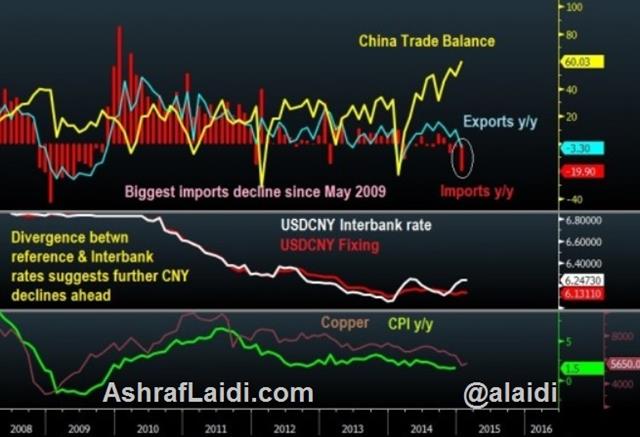The 19% y/y slump in China's trade balance was the biggest decline since May 2009 and the seventh decrease over the last 12 months. The plunge in imports was the primary driver behind the new record-high trade surplus of $60 bn as exports fell 3.3%, posting their first decline in 10 months. Disappointing China figures ahead of G20 meetings are far from rare, but the long-term trend in the data is another reminder that Beijing will cut its benchmark lending/borrowing rates and pave the way for further CNY depreciation, which Western lawmakers can do little about.

Cant' Blame It On The Goat
Chinese data divergences in January and February are usually dismissed as being caused by distortions relating to the Chinese Lunar New Year holiday. But this year's holiday -- the Year of the Goat -- isn't scheduled to start until late February, leaving January immune from holiday stoppages. And the recent consistency of the decline in Chinese imports -- not seen since the 2008-9 crisis -- has been partly due to slumping commodity prices. Later this month, the HK trade figures figures will reveal whether China's trade data is a reflection of real trade flows rather as opposed to over-invoicing.
Further CNY Weakness Is Inevitable
Further yuan weakness is the only solution for stabilizing the prolonged decline of consumer and producer price inflation, while helping to stabilize declining exports. It's no longer the case that US lawmakers have the political capital and economic reasoning to urge China into further yuan appreciation. The IMF views China's currency as more appropriately valued while US lawmakers lack the effectiveness in pressuring Beijing over its currency after three rounds of USD-depreciating QE and one of round of Operation Twist from the Federal Reserve over the last six years.
The case for further CNY weakness ahead is not only highlighted by the glaring slowdown in Chinese data (GDP, industrial output and personal consumption), but also by the record deficit in the nation's capital and finance account balance, indicating persistent declines in hot money flows and foreign direct investment.
The ongoing divergence between the PBOC's USD/CNY reference rate and Interbank rates highlights that CNY weakness will continue ahead, either via a widening of the daily fluctuation from its current +/-2%, or a defacto devaluation. Most likely, the former option will prevail as Beijing adopts the free-market route toward policy easing.
CPI, PPI Support CNY Weakness Ahead Of G20
Tuesday's release of January inflation figures from China are expected to show CPI at 1.1% y/y from December's 1.5% y/y, which would be the lowest level since the 0.6% attained in November 2009. January PPI, already down 3.3% in December, is seen falling 3.3% -- the 34th consecutive monthly contraction, which would be the longest stretch since the 2008-09 crisis and the 1999-2000 slump.
The figures will be another signal from Beijing to ease monetary policy via cutting lending and borrowing rates, last reduced in November, to add to the selective policy of targeting specific banks with cuts in the interbank rates and reserve-requirement ratios.
